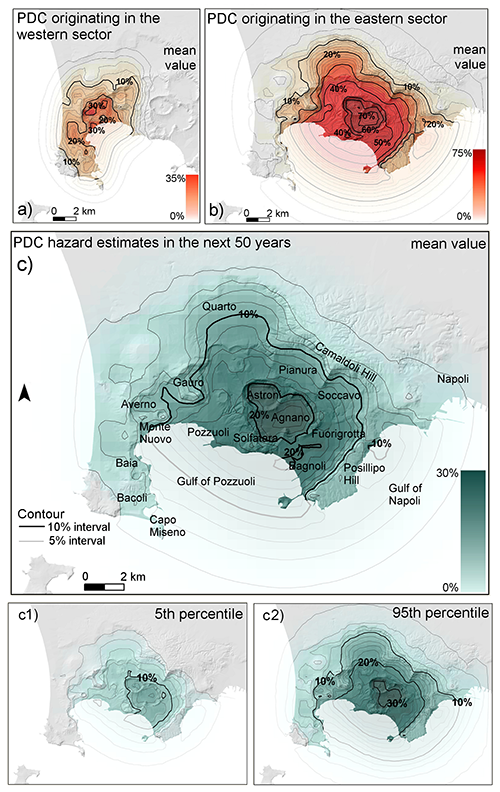Volcanic Hazard Assessment at the Campi Flegrei Caldera, Italy

uncertainty percentiles of the distribution by using the same colour scales. Figure modified after Bevilacqua et al. (2017)
Bevilacqua A., G. Macedonio, A. Neri, G. Orsi, P. Petrosino
Chapter – Active Volcanoes of the World – book series (AVOLCAN), https://doi.org/10.1007/978-3-642-37060-1_12
Abstract
The Campi Flegrei caldera is a complex and resurgent structure, and its active portion has been the site of an intense volcanism with eruptions concentrated in temporal clusters, called epochs. The caldera is home to about 350,000 people. In the past decades, many scientific studies were aimed at both defining fundamental parameters of a future eruption, and hazard zoning of the territory. The approach to the volcanic hazard assessment of the Campi Flegrei caldera has progressively changed through time from a “deterministic” interpretation of the available information to a quantitative probabilistic elaboration of the main sources of uncertainty. In particular, on the long-term, Astroni-Agnano-Solfatara is recognised to be the most probable area in which a vent will likely open, while the Averno-Monte Nuovo is the second most probable one. Significant uncertainty affects these results, and a non-negligible vent opening probability spreads over the whole caldera. The inter-event times of volcanic eruptions span from a few years to thousands of years. Within the epochs of activity, the mean recurrence time is tens of years, and intra-epoch temporal groups are evident. The probability that the next eruption will be of < 0.1 km3 volume of magma DRE is ~95%. Larger size eruptions tend to be localised in the central-eastern sector of the caldera. Expected hazards from renewal of explosive volcanism result from pyroclastic fallout and pyroclastic density currents. Pyroclastic fallout deposits in excess of 300 kg/m2 can affect most of the caldera and the city of Naples with more than 10% probability. The entire caldera has the potential to be affected by pyroclastic density currents invasion with mean probability above 30% in its central-eastern portion, and above 50% in the Agnano area. Invasion probabilities of ~5–10% have been estimated for the urbanised areas along the eastern slopes of the Posillipo Hill. In summary, probabilistic hazard assessment is particularly important in Campi Flegrei caldera, due to the uncertain location for potential vents and the large variability of eruption styles and sizes that cannot be, at the present time, effectively constrained by monitoring signals.


Devi effettuare l'accesso per postare un commento.